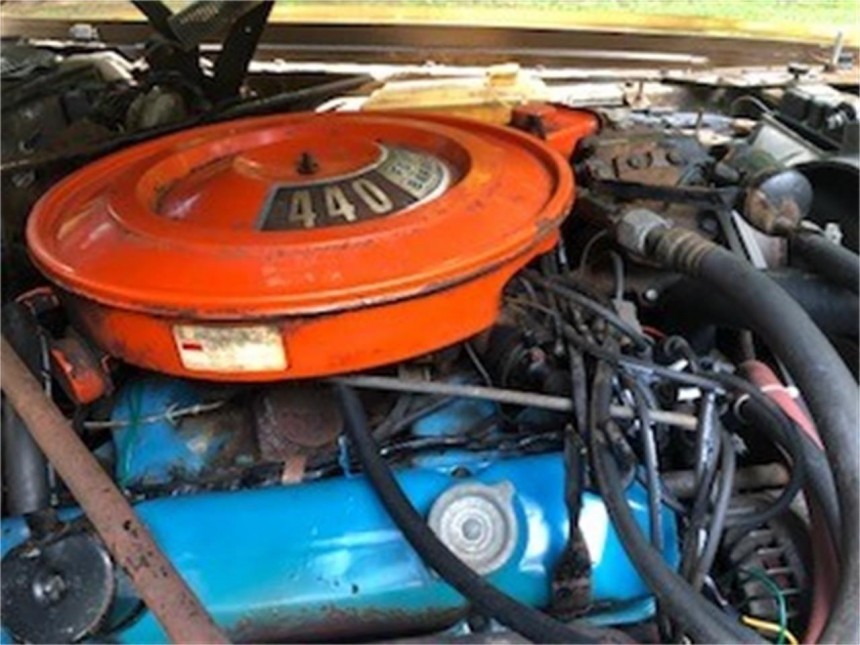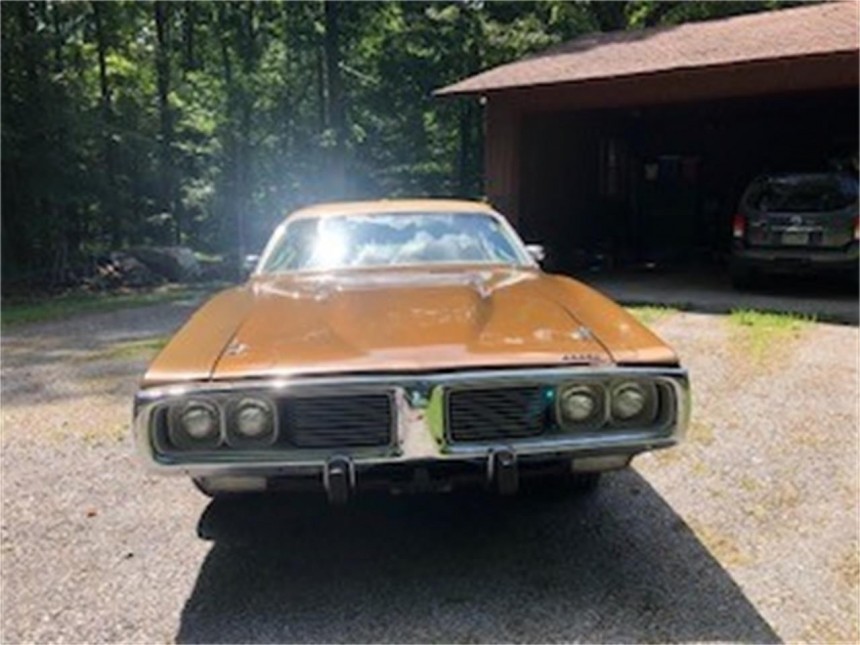The third-generation Dodge Charger emerged during a turning point in the history of not only the marque but also the whole of the American motoring paradigm. It was released for the 1971 model year and lasted until what is generally agreed upon to be the end of the muscle car age in 1974. Despite its high-performance aura and near-mythical tenure, the famous Chargers of ’68-’70 weren’t the best-sellers of the nameplate. That merit goes to the Malaise-launched Mopars, although they no longer held the status-symbol glow of the muscle-bound heroes of the late sixties.
In 1973, the Charger sales reached an all-time high, at over 119,000 units – almost 27,000 more than the famous model of 1968. Granted, the Dodge icon was shifting its sales pitch from the muscle car attitude toward a domesticated ‘personal luxury coupe’ mantra. With the HEMI a nostalgic memory from before 1971, the Charger faced increasing fuel prices, tighter emissions regulations, smothering insurance premiums, and whatever else tire smoke haters could think of.
Beginning with the Charger’s third generation, in 1971, the model became a two-door version of the Dodge Coronet platform. Well, either that or the Charger was a coupe variant of the Coronet sedan. The car had all but lost much of its sinister looks of the fabled ‘68-’70 thundering ‘Mach 2 jet on wheels’ apparel, as it was lauded in the official brochures.
Returning to the unmistakable 1969 and its split grille, the third generation would proudly wear the vertical separator in the middle of its front end. The semi-swept roofline aligned with the coke-bottle profile, and the Charger was a somewhat more civilized relative of the ruffian it was born as.
Unfortunately, the sad news lay under the hood, where buyers couldn’t find the notorious scripting stating ‘426 hemi heads.’ The crown jewel of Mopar had been retired at the end of 1971 while it was still at the top of the muscle castle. By 1973, nothing about the business end of the Charger reminded prospects of the origins of this emblematic nameplate.
The air-cleaning resolutions took performance down, and the Society of Automotive Engineering also kicked marketing in the head. Since the power and torque ratings were stated ‘as installed,’ the numbers were disgracefully low compared to the peak of the Golden Era. With the HEMI out of sight, Dodge relied on three V8s and an inline Six to put the charge in the Charger of 1973.
Two engines were standard in the domesticated Charger: a 225-cubic-inch I6 (3.7-liter) and a 318 V8 (the famous Mopar 5.2-liter small-block that served the Chrysler Corporation with loyalty for a good number of years). Optional plants were the 340-CID motor (5.6 liters) – but only for the Rally Package cars – a duo of 400s/ 6.6 liters (evolved from the notorious 383 big-block V8), and the Magnum. The legendary 440 incher (7.2 liters) was still around, albeit only in the toned-down four-Venturi carburetion with 280 hp and 340 lb-ft (284 PS, 461 Nm)..
A far cry from the extinct Six-Pack of 1970, and the change showed everywhere. Beginning with the sales literature of the time. Consider this: in the most productive year of the muscle car epoch, the Charger was introduced as ‘A study in aggressiveness that is not recommended for timid souls.’ The same document, printed in 1973, presented the same automobile as being ‘Built for the "take charge" driver. Start with Charger's new Torsion-Quiet Ride - a tight, responsive suspension system.’
We clearly see the difference – but the general stream of the period muffled everyone else in Detroit. Speed was the antichrist, and good gas mileage was a high virtue worthy of beatification. And, since there was no real going back to the tire-shrieking days (and nights) of the ‘Stoplight Grand Nationals,’ it made sense for customers to choose comfort.
It makes a lot more sense now when the Dodge Charger from the dawn of the Malaise is a classic collectible. Not held in the high praise of the second-gen demigods (and hemigods), the Chargers of 1971 through 1974 are still getting their fair share of attention. Especially when they’re original survivors, like this particular Dalton, Georgia example we see in the video.
This lean machine of a Mopar sports its factory-installed everything and has had one owner for the past 50 years. One that knew how to pamper a noble Mopar nameplate – and the proof is this running, driving survivor. The odometer reads 44,447 miles – 71,515 kilometers – because the proprietor decided to protect it as much as possible following a regrettable incident.
While sitting in a parking lot, another car mauled the Charger on the passenger side. The damage was only skin deep, so the repair was performed locally (dent pulled out and painted). The rebuilt 440-4 is mated to an automatic with a slap-stick shifter and does get regular exercise in a controlled environment.
The car has new tires, belts, and sparkplugs, needs the vinyl top, driver's seat, and the top of the back seat addressed, and was last on the road in the summer of 2021. But the owner does run it every other day to keep it fresh. It’s a pretty well-optioned Charger with air conditioning, power steering and power brakes, AM/FM radio, and buckets upfront. All this for $35,000 – not exactly the bottom of the classic carpool, but pretty good for a Charger.
Beginning with the Charger’s third generation, in 1971, the model became a two-door version of the Dodge Coronet platform. Well, either that or the Charger was a coupe variant of the Coronet sedan. The car had all but lost much of its sinister looks of the fabled ‘68-’70 thundering ‘Mach 2 jet on wheels’ apparel, as it was lauded in the official brochures.
Returning to the unmistakable 1969 and its split grille, the third generation would proudly wear the vertical separator in the middle of its front end. The semi-swept roofline aligned with the coke-bottle profile, and the Charger was a somewhat more civilized relative of the ruffian it was born as.
The air-cleaning resolutions took performance down, and the Society of Automotive Engineering also kicked marketing in the head. Since the power and torque ratings were stated ‘as installed,’ the numbers were disgracefully low compared to the peak of the Golden Era. With the HEMI out of sight, Dodge relied on three V8s and an inline Six to put the charge in the Charger of 1973.
Two engines were standard in the domesticated Charger: a 225-cubic-inch I6 (3.7-liter) and a 318 V8 (the famous Mopar 5.2-liter small-block that served the Chrysler Corporation with loyalty for a good number of years). Optional plants were the 340-CID motor (5.6 liters) – but only for the Rally Package cars – a duo of 400s/ 6.6 liters (evolved from the notorious 383 big-block V8), and the Magnum. The legendary 440 incher (7.2 liters) was still around, albeit only in the toned-down four-Venturi carburetion with 280 hp and 340 lb-ft (284 PS, 461 Nm)..
We clearly see the difference – but the general stream of the period muffled everyone else in Detroit. Speed was the antichrist, and good gas mileage was a high virtue worthy of beatification. And, since there was no real going back to the tire-shrieking days (and nights) of the ‘Stoplight Grand Nationals,’ it made sense for customers to choose comfort.
It makes a lot more sense now when the Dodge Charger from the dawn of the Malaise is a classic collectible. Not held in the high praise of the second-gen demigods (and hemigods), the Chargers of 1971 through 1974 are still getting their fair share of attention. Especially when they’re original survivors, like this particular Dalton, Georgia example we see in the video.
While sitting in a parking lot, another car mauled the Charger on the passenger side. The damage was only skin deep, so the repair was performed locally (dent pulled out and painted). The rebuilt 440-4 is mated to an automatic with a slap-stick shifter and does get regular exercise in a controlled environment.
The car has new tires, belts, and sparkplugs, needs the vinyl top, driver's seat, and the top of the back seat addressed, and was last on the road in the summer of 2021. But the owner does run it every other day to keep it fresh. It’s a pretty well-optioned Charger with air conditioning, power steering and power brakes, AM/FM radio, and buckets upfront. All this for $35,000 – not exactly the bottom of the classic carpool, but pretty good for a Charger.








































